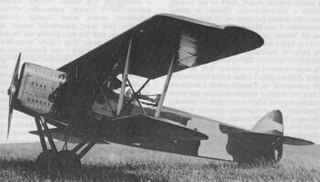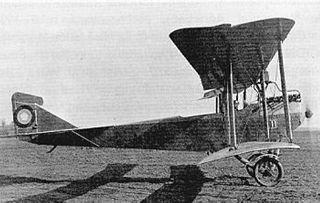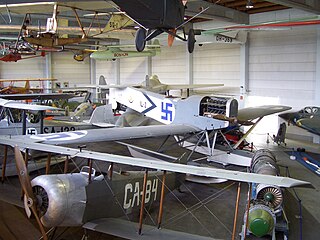| A.26 | |
|---|---|
| Role | Reconnaissance |
| National origin | Czechoslovakia |
| Manufacturer | Aero Vodochody |
| First flight | 1923 |
| Developed from | Hansa-Brandenburg B.I |
The Aero A.26 was a Czechoslovakian military reconnaissance biplane aircraft built by Aero Vodochody in the 1920s. It was Aero's last design to be based on the Hansa-Brandenburg B.I aircraft that the company had been building under licence during World War I as the Ae.10.
It first flew in 1923 and a small series was built. They were later used in the Czechoslovak civilian aviation.
Data from[ citation needed ]
General characteristics
Performance
Armament
Related development

The Aero A.11 was a biplane light bomber and reconnaissance aircraft built in Czechoslovakia between the First and Second World Wars. It formed the basis for many other Czechoslovakian military aircraft of the inter-war period. Around 250 were built, with some remaining in service at the outbreak of World War II.

The Aero A.12 was a Czechoslovakian biplane light bomber and military reconnaissance aircraft manufactured in small numbers shortly after World War I. Although reminiscent of the Hansa-Brandenburg-designed aircraft that Aero was building during the war under licence as the Ae.10, the A.12 was the company's own design. It is perhaps most significant as the direct descendant of the highly successful A.11 and its various derivatives. An example of the type is preserved at the Letecké Muzeum in Kbely.

The Aero A.14 was a Czechoslovakian biplane military reconnaissance aircraft built in the 1920s. It was essentially a slightly modified version of the Hansa-Brandenburg C.I aircraft that Aero had built during World War I as the Ae.10, and for this reason, the aircraft is sometimes referred to as the A.14 Brandenburg. When equipped with a slightly different engine, the aircraft was designated A.15 instead. The two versions were otherwise almost identical.
The Aero A.21 was a biplane military trainer aircraft developed in Czechoslovakia from the Aero A.11 reconnaissance-bomber. The aircraft was developed specifically as a night-trainer, to teach Czech Air Force pilots instrument flying techniques.

The Aero A.29 was a military biplane developed in Czechoslovakia from the ubiquitous Aero A.11 reconnaissance-bomber. Aero equipped it with floats and it served as a target tug for training anti-aircraft gunners.
The Aero A.22 was a Czechoslovakian biplane civil utility aircraft based on the Aero A.12 reconnaissance-bomber. The observer's position was replaced by seating for two passengers.

The Aero A.38 was a Czechoslovakian biplane airliner of the 1920s and 1930s. Following the relatively modern A.35, this aircraft was something of a throwback, marrying a fuselage derived from the A.35 to wings copied from the A.23. A few served with CSA, and others with French airline Compagnie Internationale de Navigation Aérienne. These latter aircraft were powered by a French Gnome-Rhône engine instead.

The Aero A.200 was a sportsplane of Czechoslovakia, designed and built specifically to compete in Challenge 1934, the European touring plane championships. It was a four-seater low-wing monoplane.

The Aero Ae 01 was a Czechoslovakian military trainer biplane built in 1919 and was Aero's first attempt to modify one of the aircraft designs they had been manufacturing under licence during World War I, the Hansa-Brandenburg B.I. The project was originally designated as Ae 10, but later re-designated to Ae 01. The army operated the aircraft under designation A-1.

The Hansa-Brandenburg B.I was an unarmed military trainer and reconnaissance biplane of World War I, flown by the Austro-Hungarian Air Service. Early models were known internally to the Hansa-Brandenburg firm as the type D, while later models with a more powerful engine were designated FD. This aircraft was one of the earliest designs of Ernst Heinkel, who was working for Hansa-Brandenburg at the time. It was an entirely conventional two-bay biplane with staggered wings of unequal span. The pilot and observer sat in tandem in a long open cockpit.

IVL A.22 Hansa was a Finnish license copy of the German two-seat, low winged single-engined seaplane Hansa-Brandenburg W.33, which had been designed by Hansa und Brandenburgische Flugzeugwerke in the 1920s.

The Hansa-Brandenburg C.I, also known as Type LDD, was a 2-seater armed single-engine reconnaissance biplane designed by Ernst Heinkel, who worked at that time for the parent company in Germany. The C.I had similarities with the earlier B.I, including inward-sloping interplane bracing struts. Like other early-war Austro-Hungarian reconnaissance aircraft, such as C-types of Lloyd or Lohner, the Type LDD had a communal cockpit for its crew.

The Hansa-Brandenburg CC was a single-seat German fighter flying boat of World War I. It was used by both the Kaiserliche Marine and the Austro-Hungarian Navy.

The Flaeming Air FA 04 Peregrine is a German ultralight and light-sport aircraft, designed and produced by Flaeming Air of Zellendorf, Brandenburg. The aircraft is supplied as a complete ready-to-fly-aircraft.

The Skyleader GP One is a Czech ultralight aircraft, designed and produced by Skyleader Aircraft and introduced at the AERO Friedrichshafen show in 2010. The aircraft is supplied as a complete ready-to-fly-aircraft.
The Bagalini Colombo is an Italian homebuilt aircraft that was designed by Marino Bagalini. The aircraft is supplied in the form of plans for amateur construction.
The ICP Amigo is an Italian homebuilt aircraft that was designed and produced by ICP srl of Piovà Massaia. When it was available the aircraft was supplied as a kit for amateur construction.

The Performance Aircraft Formula GT is an American homebuilt aircraft that was designed and produced by Performance Aircraft of Olathe, Kansas, introduced in the 1990s. When it was available the aircraft was supplied as a kit for amateur construction.
Hansa-Brandenburg W.34 was a prototype German two-seat, low-wing single-engined seaplane, which had been designed by Hansa und Brandenburgische Flugzeugwerke during World War I.
The Hansa-Brandenburg W.23 was a German flying boat fighter of World War I.